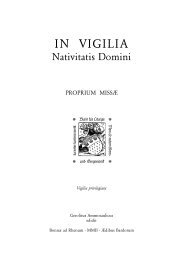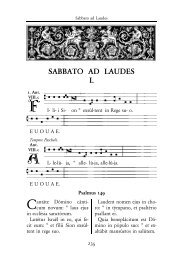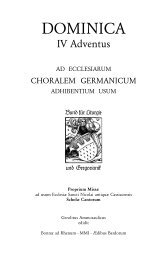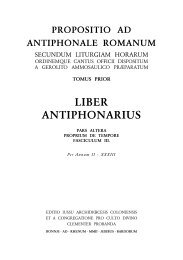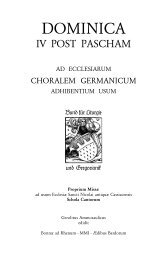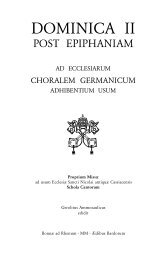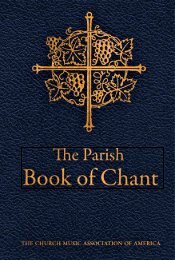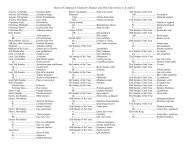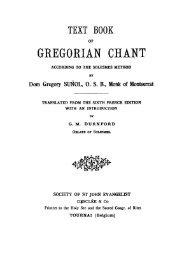The Bugnini-Liturgy and the Reform of the Reform - MusicaSacra
The Bugnini-Liturgy and the Reform of the Reform - MusicaSacra
The Bugnini-Liturgy and the Reform of the Reform - MusicaSacra
You also want an ePaper? Increase the reach of your titles
YUMPU automatically turns print PDFs into web optimized ePapers that Google loves.
<strong>The</strong> new reform, however, did not find <strong>the</strong>m suitable. <strong>The</strong> prophecy <strong>of</strong><br />
Isaiah about <strong>the</strong> suffering Messiah was transferred from Holy Wednesday<br />
to <strong>the</strong> first place here <strong>and</strong>, as <strong>the</strong> second reading, <strong>the</strong> <strong>the</strong>ological discourse<br />
on suffering from <strong>the</strong> Epistie to <strong>the</strong> Hebrews can be heard. Both are important<br />
<strong>and</strong> fitting to <strong>the</strong> day. <strong>The</strong>re is, however, <strong>the</strong> impression that <strong>the</strong> change<br />
went toge<strong>the</strong>r with a certain loss, too. <strong>The</strong> pericope about <strong>the</strong> sacrifice <strong>of</strong><br />
<strong>the</strong> Lamb was taken over to <strong>the</strong> Mass on Maundy Thursday so as to emphasize<br />
<strong>the</strong> relationship between <strong>the</strong> Sacred Meal <strong>of</strong> <strong>the</strong> New Testament <strong>and</strong><br />
<strong>the</strong> Cena Agni <strong>of</strong> <strong>the</strong> Old Testament. In my opinion <strong>the</strong> long text <strong>of</strong> Isaiah<br />
with its almost lyrical tone was at a better place in <strong>the</strong> period preceding <strong>and</strong><br />
preparing <strong>the</strong> holy days. <strong>The</strong> pericope about <strong>the</strong> killing <strong>of</strong> <strong>the</strong> Lamb collated<br />
<strong>the</strong> Pascha <strong>of</strong> <strong>the</strong> two Testaments <strong>and</strong> by doing so it represented<br />
<strong>the</strong> "nunc" <strong>of</strong> Good Friday as a meeting point <strong>of</strong> <strong>the</strong> great mysteries <strong>of</strong> <strong>the</strong><br />
oeconomia salutis. I think Maundy Thursday could have been left with one<br />
reading <strong>and</strong> <strong>the</strong> Gospel according to <strong>the</strong> ferial order, for <strong>the</strong>n <strong>the</strong> text on<br />
<strong>the</strong> Lamb could have remained in its <strong>the</strong>ologically justified place on Friday.<br />
If we compare <strong>the</strong> text <strong>of</strong> Isaiah with <strong>the</strong> prophecy <strong>of</strong> Hosea, we will find<br />
that <strong>the</strong> latter - instead <strong>of</strong> depicting <strong>the</strong> sufferings in detail - calls our attention<br />
to <strong>the</strong> objectivity <strong>of</strong> <strong>the</strong> divine deed manifested in <strong>the</strong> Paschal Mystery.<br />
It seems, however, that we may not count on <strong>the</strong> underst<strong>and</strong>ing <strong>of</strong> this<br />
paragraph <strong>the</strong>se days <strong>and</strong> so <strong>the</strong> reading <strong>of</strong> Isaiah remains <strong>the</strong> more practical<br />
solution.<br />
In my eyes <strong>the</strong> elimination <strong>of</strong> <strong>the</strong> tract from Habakkuk is <strong>of</strong> even<br />
greater loss. In <strong>the</strong> Christian antiquity this text expressed <strong>the</strong> amazement <strong>of</strong><br />
<strong>the</strong> Church not only on Good Friday (when God manifested himself "in<br />
medio duorum animalium" in justice <strong>and</strong> pity ("in ira misericordiae memor");<br />
but also on o<strong>the</strong>r days proclaiming God's magnificent deeds (e.g. in<br />
<strong>the</strong> Christmas Office or <strong>the</strong> liturgy <strong>of</strong> <strong>the</strong> Easter Vigil <strong>of</strong> <strong>the</strong> Beneventan<br />
church, etc.). "Lord, I have seen your work <strong>and</strong> I am disturbed..." In <strong>the</strong><br />
present rite we sing a less characteristic tract after <strong>the</strong> first reading <strong>and</strong><br />
a gradual after <strong>the</strong> second reading (again in a quite absurd sequence as regards<br />
chant tradition!).<br />
<strong>The</strong> place <strong>of</strong> <strong>the</strong> solemn prayers has been retained by <strong>the</strong> <strong>Bugnini</strong> liturgy<br />
as well, whereas <strong>the</strong> text is substantially rewritten. This new text would<br />
deserve a separate study. At any rate, <strong>the</strong> inserted new elements are conspicuous<br />
among <strong>the</strong> classic phrases by virtue <strong>of</strong> <strong>the</strong>ir*style <strong>and</strong> loquacity.<br />
34




